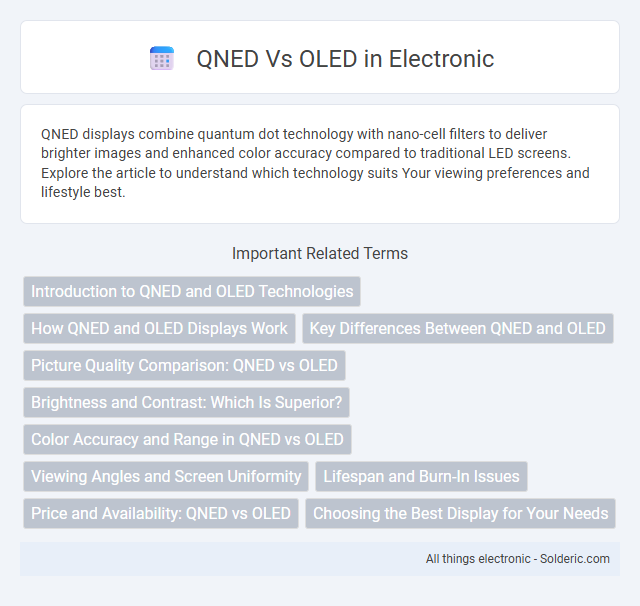QNED displays combine quantum dot technology with nano-cell filters to deliver brighter images and enhanced color accuracy compared to traditional LED screens. Explore the article to understand which technology suits Your viewing preferences and lifestyle best.
Comparison Table
| Feature | QNED | OLED |
|---|---|---|
| Technology | Mini LED backlight with Quantum Dot and NanoCell layers | Organic Light Emitting Diode (self-emissive pixels) |
| Brightness | Higher peak brightness, ideal for HDR in bright rooms | Lower peak brightness but excellent in dark environments |
| Contrast Ratio | Very good, improved local dimming zones | Perfect black levels, infinite contrast ratio |
| Color Accuracy | Wide color gamut with Quantum Dots | Exceptional color accuracy and wide gamut |
| Viewing Angles | Good but less than OLED | Excellent, minimal color shift from angles |
| Burn-in Risk | No burn-in risk | Possible burn-in with static images over time |
| Lifespan | Longer lifespan due to LED backlighting | Shorter lifespan due to organic materials |
| Price | Generally more affordable than OLED | Premium price due to advanced tech |
Introduction to QNED and OLED Technologies
QNED technology combines Quantum Dot and NanoCell layers with Mini LED backlighting to enhance brightness, color accuracy, and contrast in LCD panels. OLED technology uses organic compounds that emit light individually, enabling true blacks, wide viewing angles, and vibrant colors without the need for backlighting. Both technologies deliver advanced display performance but differ significantly in light emission methods and panel structure.
How QNED and OLED Displays Work
QNED displays combine Quantum Dot and NanoCell technologies with Mini-LED backlighting to enhance color accuracy, brightness, and contrast through precise local dimming zones. OLED panels use organic compounds that emit light individually when an electric current passes through, allowing for true blacks and infinite contrast without a backlight. The key difference lies in QNED's reliance on Mini-LED backlight control compared to OLED's self-emissive pixels.
Key Differences Between QNED and OLED
QNED technology combines Quantum Dot and NanoCell layers with Mini LED backlighting to enhance brightness and color accuracy, while OLED features self-emissive pixels that deliver superior contrast and true blacks. QNED typically offers higher peak brightness and improved screen uniformity, whereas OLED excels in response time and viewing angles. Your choice depends on whether you prioritize vibrant brightness and durability (QNED) or perfect black levels and color depth (OLED).
Picture Quality Comparison: QNED vs OLED
QNED TVs utilize Quantum Dot and NanoCell technologies combined with Mini-LED backlighting to deliver higher peak brightness and improved local dimming compared to traditional LED displays, resulting in enhanced contrast and more vivid colors. OLED panels offer perfect black levels and infinite contrast due to their self-emissive nature, providing superior color accuracy and wide viewing angles. In terms of picture quality, OLED excels in deep blacks and uniformity, while QNED outperforms in brightness and HDR performance, making both technologies suitable for different viewing preferences and lighting environments.
Brightness and Contrast: Which Is Superior?
QNED technology delivers higher peak brightness levels, making it ideal for well-lit rooms and HDR content viewing. OLED excels in contrast due to its self-emissive pixels that produce perfect blacks by completely turning off individual pixels. Your choice depends on whether you prioritize vivid brightness or superior contrast in your viewing experience.
Color Accuracy and Range in QNED vs OLED
QNED displays utilize Quantum Dot and NanoCell technologies combined with Mini LED backlighting to deliver enhanced color accuracy and a wider color gamut compared to traditional LED displays, achieving rich and vivid hues. OLED panels inherently provide exceptional color accuracy and an infinite contrast ratio due to their self-emissive pixels, enabling deeper blacks and more precise color rendition across various viewing angles. While QNED improves brightness and color volume, OLED remains superior for true-to-life color consistency and dynamic range in darker scenes.
Viewing Angles and Screen Uniformity
QNED technology delivers exceptional screen uniformity with minimal color shift across wide viewing angles, ensuring consistent picture quality even from the sides. OLED panels use self-emissive pixels that maintain true blacks and vibrant colors but may exhibit slight brightness and color changes at extreme angles. For consumers seeking stable image consistency and uniform brightness, QNED offers a significant advantage in viewing angle performance compared to OLED displays.
Lifespan and Burn-In Issues
QNED TVs typically offer a longer lifespan compared to OLEDs due to their use of quantum dot and nano cell technology, which is less prone to organic material degradation. OLED displays, while providing superior contrast and deeper blacks, may suffer from burn-in issues after prolonged exposure to static images, impacting their durability. Understanding these differences helps you choose a TV best suited to your viewing habits and longevity expectations.
Price and Availability: QNED vs OLED
QNED TVs typically offer more affordable price points compared to OLEDs, making them accessible to a broader range of consumers. OLED technology remains premium, with higher costs due to complex manufacturing processes and limited production scale. You can find QNED models more widely available across various screen sizes and brands, whereas OLED options may be limited to specific manufacturers and select sizes.
Choosing the Best Display for Your Needs
QNED technology combines Quantum Dot and NanoCell layers for enhanced brightness and color accuracy, making it ideal for well-lit environments and vibrant visuals. OLED displays offer unparalleled contrast and true blacks due to self-emissive pixels, perfect for cinematic experiences and dark room viewing. Selecting the best display depends on your usage: QNED suits brighter rooms and vivid imagery, while OLED excels in contrast-rich, immersive viewing scenarios.
QNED vs OLED Infographic

 solderic.com
solderic.com